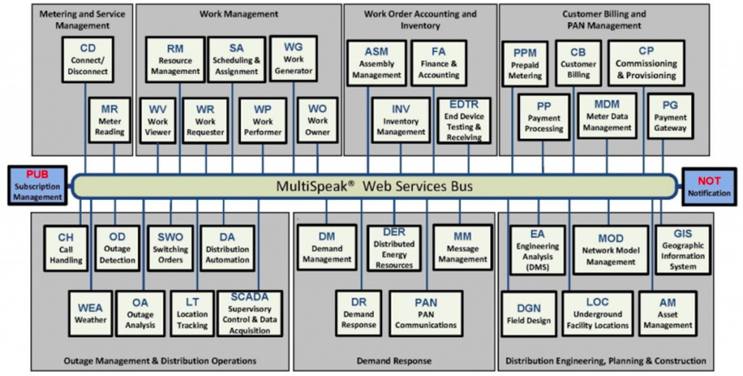Water Meter Data Management — To Sink Or SWIM (Part 2)
By Jeff Lipton, VP of Marketing and Business Development, WaterSmart Software
In part 2 of this post (see part 1 here), we review additional benefits and challenges of an MDM and what ideal technology solution best suits water industry needs:
Benefit and Challenge 2: Interoperability
Electric utilities have a large number of data systems (as many as 12+) that require metering information. Getting access to all this data is no small feat (see diagram below).

The National Rural Electric Coop Association (catering to utilities under 300k endpoints) has developed a standard for meter data system interoperability known as MultiSpeak. From the MultiSpeak About page:
The MultiSpeak Specification is a key industry-wide standard for realizing the potential of enterprise application interoperability. The MultiSpeak Specification is the most widely applied de facto standard in North America pertaining to distribution utilities and all portions of vertically-integrated utilities except generation and power marketing.
Unfortunately, the water utility industry has no equivalent initiative to MultiSpeak. Without a standard, system integration becomes a reality only with massive custom integration efforts on a case-by-case basis, or through vendor-to-vendor partnerships. Both are costly and require the utility to assume some level of risk. Even enhancing interoperability with the billing system, the one system historically “in scope” for AMI/MDM integration, often proves difficult.
Benefit and Challenge 3: Scale
Since most electric utilities are very large, they need data warehouse systems that are built for massive scale and are highly reliable. Electric MDM providers have built systems to match such needs. The industry now utilizes highly robust, though relatively expensive systems that meet the specific needs of electric utilities.
Water utilities are much smaller and draw from a significantly smaller base of ratepayers, making a massively scalable, reliable MDM offered to electric utilities cost prohibitive. Consequently, there emerges a significant mismatch between need and budget when it comes to the requirements of a water MDM.
Current State in the Water Industry
The current state of the water industry as it relates to the MDM concept is in a state of flux. A few disruptive entrants into the market are creating confusion with MDM “like” products while consultants are increasingly encouraging utilities to require true MDM functionality and meter technology independence. However, interoperability challenges coupled with a lack of technical skills at most water utilities are ever-present.
Scalable and cost-effective meter and network agnostic water MDM solutions are clearly desired by water utilities. Such solutions should include affordable, long-term data storage and cleansing, and billing read exports. A dedicated water MDM can help utilities avoid vendor-lock in while easily piloting multiple meter and network technologies. Since the MDM is essentially a file storage and software solution, it can be deployed in the cloud at very low cost with the ability to quickly and easily scale on demand while offering the ability to dynamically update software features as new reporting or export format requirements become relevant.
A System for Water Information Management (SWIM) is an inevitability for the industry and will likely be a crucial step to improving data interoperability through protocol standardization and help increase the adoption rate of AMI technologies to drive down system costs and improve service reliability. This would be a benefit to end-use customers, water utilities, and the communities that they serve.
About the author:
 Jeff manages WaterSmart Software’s go-to-market strategy development and marketing campaign activities, along with sales operations support. Prior to WaterSmart, Jeff managed channel development and regional field marketing for EnerNOC, an international leader in energy intelligence software and demand response solutions. He joined EnerNOC from Coyle Industries, where he pioneered the development of renewable distributed generation solar power systems for military, developing world, and other off-grid electrical applications. Jeff previously spent a decade in the digital media industry where he held various product management, marketing, and executive sales positions. Jeff began his career as a commercial audio recording engineer and producer. Jeff earned a Master of Business Administration from the Haas School of Business at the University of California. He also received a BA in Political Science from the University of Colorado where he was elected Phi Beta Kappa and graduated Magna Cum Laude.
Jeff manages WaterSmart Software’s go-to-market strategy development and marketing campaign activities, along with sales operations support. Prior to WaterSmart, Jeff managed channel development and regional field marketing for EnerNOC, an international leader in energy intelligence software and demand response solutions. He joined EnerNOC from Coyle Industries, where he pioneered the development of renewable distributed generation solar power systems for military, developing world, and other off-grid electrical applications. Jeff previously spent a decade in the digital media industry where he held various product management, marketing, and executive sales positions. Jeff began his career as a commercial audio recording engineer and producer. Jeff earned a Master of Business Administration from the Haas School of Business at the University of California. He also received a BA in Political Science from the University of Colorado where he was elected Phi Beta Kappa and graduated Magna Cum Laude.
